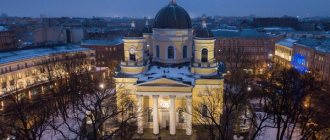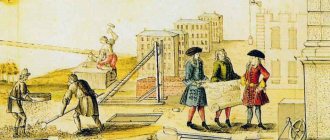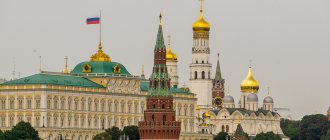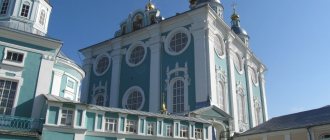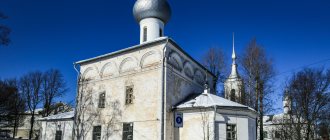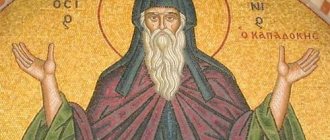Trullo or Fifth-Sixth Council
, took place in Constantinople in 691-692.
The VI Ecumenical Council is also known under the name of Trullo.
- On the map: Yandex.Map, Google map (no exact coordinates)
The Council of Trullo was convened by Emperor Justinian II in 691 in Constantinople. The Fifth and Sixth Ecumenical Councils did not make any definitions, focusing on the dogmatic needs of the Church and the fight against heresies. Meanwhile, the decline of discipline and piety intensified in the Church. The new Council was conceived as an addition to previous Councils, designed to unify and supplement church norms. The council was assembled in the same hall as the VI Ecumenical Council, clearly representing its continuation, and with the same universal significance. “trulli”, was reserved for its meetings.
, and the entire cathedral was officially given the name of Trullo in documents. And the task of completing the canons of two ecumenical councils - V and VI - is indicated by the addition to its name: “Fifth-Sixth - πενθεκτη” (Quinsextus).
The result of the activities of the Trullo Council were 102 canonical rules adopted at it (some of these canons repeat the rules of previous Ecumenical Councils). They formed the basis for the development of Orthodox canon law.
The Orthodox Church united the Trullo Council with the VI Ecumenical Council, considering it as a continuation of the VI Council. Therefore, the 102 canons of the Trullo Council are sometimes called the Rules of the VI Ecumenical Council. The Roman Catholic Church, recognizing the Sixth Council as Ecumenical, did not recognize the resolutions of the Trullo Council, and, of necessity, considers it as a separate council.
The 102 canons of the Trullo Council openly paint a broad picture of ecclesiastical and moral disorders and strive to eliminate all of them, thereby reminding us of the tasks of our Russian councils: the Vladimir Council of 1274 and the Moscow Council of 1551.
Canons of Trullo Cathedral and the Roman Church
Many of the canons were polemically directed against the Roman Church or, in general, were alien to it. For example, canon 2 asserts the authority of 85 canons of the apostolic and other eastern councils, which the Roman Church did not consider binding on itself. The Romans used a collection of 50 apostolic rules of Dionysius the Less, but they were not considered binding. Canon 36 renewed the famous 28th rule of the Council of Chalcedon, which was not accepted by Rome. Canon 13 went against the celibacy of the clergy. Canon 55 went against the Roman post on the Sabbath. And other canons: the 16th about the seven deacons, the 52nd about the liturgy of the presanctified, the 57th about giving milk and honey into the mouth of the newly baptized - all this was against the customs of the Roman Church, sometimes openly called so.
Papal representatives in Constantinople signed the acts of the Council of Trullo. But when these acts were sent to Pope Sergius in Rome for signature, he flatly refused to sign them, calling them errors. Subsequently, before the division of churches, Constantinople made repeated attempts to convince Rome to accept the acts of the Trullo Council (from an attempt to forcefully bring the Pope from Rome to Constantinople to “resolve” this issue, to persuasion to revise the 102 rules, correct, reject what the pope finds necessary, and accept the rest), which gave varying results, but in the end the Roman Church never recognized the Council of Trullo.
Story
The Fifth and Sixth Ecumenical Councils did not make any definitions, focusing on the dogmatic needs of the Church and the fight against heresies.
But due to the fact that the decline of discipline and piety in the Church was intensifying, it was decided to convene an additional Council to the previous ones, which would unify and supplement church norms.
The council met in the same room as the VI Ecumenical Council - the hall of the palace with vaults, the so-called trulli
, therefore, officially in the documents he was given the name of Trullo.
Excerpt characterizing the Trullo Cathedral
- A! Warrior! Do you want to conquer Bonaparte? - said the old man and shook his powdered head, as much as the braided braid in Tikhon’s hands allowed. “At least take good care of him, otherwise he’ll soon write us down as his subjects.” - Great! - And he stuck out his cheek. The old man was in good spirits after a pre-dinner nap. (He said that after lunch there is a silver dream, and before lunch there is a golden dream.) He joyfully glanced sideways at his son from under his thick, overhanging eyebrows. Prince Andrei came up and kissed his father in the place he indicated. He did not answer his father’s favorite topic of conversation - making fun of the current military people, and especially Bonaparte. “Yes, I came to you, father, and with my pregnant wife,” said Prince Andrei, watching with animated and respectful eyes the movement of every feature of his father’s face. – How is your health? “Unhealthy, brother, there are only fools and libertines, but you know me: busy from morning to evening, abstinent, and well, healthy.” “Thank God,” said the son, smiling. - God has nothing to do with it. Well, tell me,” he continued, returning to his favorite hobby, “how the Germans taught you to fight with Bonaparte according to your new science, called strategy. Prince Andrei smiled. “Let me come to my senses, father,” he said with a smile, showing that his father’s weaknesses did not prevent him from respecting and loving him. - After all, I haven’t settled in yet. “You’re lying, you’re lying,” the old man shouted, shaking his braid to see if it was braided tightly, and grabbing his son’s hand. - The house is ready for your wife. Princess Marya will take her and show her and talk a lot about her. This is their woman's business. I'm glad for her. Sit and tell me. I understand Mikhelson’s army, Tolstoy too... a one-time landing... What will the Southern Army do? Prussia, neutrality... I know that. Austria what? - he said, getting up from his chair and walking around the room with Tikhon running and handing pieces of clothing. - Sweden what? How will Pomerania be transferred? Prince Andrey, seeing the urgency of his father’s demand, at first reluctantly, but then more and more animated and involuntarily, in the middle of the story, out of habit, switching from Russian to French, began to outline the operational plan of the proposed campaign. He told how an army of ninety thousand had to threaten Prussia in order to bring it out of neutrality and draw it into the war, how part of these troops had to unite with the Swedish troops in Stralsund, how two hundred and twenty thousand Austrians, in conjunction with one hundred thousand Russians, had to act in Italy and on the Rhine, and how fifty thousand Russians and fifty thousand Englishmen would land in Naples, and how, as a result, an army of five hundred thousand had to attack the French from different sides. The old prince did not show the slightest interest in the story, as if he was not listening, and, continuing to get dressed as he walked, unexpectedly interrupted him three times. Once he stopped him and shouted: “White!” white! This meant that Tikhon did not give him the vest he wanted. Another time he stopped and asked: “Will she give birth soon?” - and, shaking his head reproachfully, said: - Not good! Keep going, keep going. The third time, when Prince Andrei finished the description, the old man sang in a false and senile voice: “Malbroug s'en va t en guerre. Dieu sait guand reviendra.” [Malbrouk is getting ready to go on a hike. God knows when he will return.] The son just smiled. “I’m not saying that this is a plan that I approve,” said the son, “I just told you what it is.” Napoleon had already drawn up his own plan no worse than this. “Well, you didn’t tell me anything new.” - And the old man thoughtfully said to himself in a patter: - Dieu sait quand reviendra. - Go to the dining room. At the appointed hour, powdered and shaved, the prince went out into the dining room, where his daughter-in-law, Princess Marya, m lle Burien and the prince's architect, who, by a strange whim, was allowed to the table, was waiting for him, although by his position this insignificant person could not count on such an honor . The prince, who firmly adhered to the differences in status in life and rarely allowed even important provincial officials to the table, suddenly proved to the architect Mikhail Ivanovich, who was blowing his nose into a checkered handkerchief in the corner, that all people are equal, and more than once inspired his daughter that Mikhail Ivanovich was nothing worse than you and me. At the table, the prince most often turned to the dumb Mikhail Ivanovich. In the dining room, hugely high, like all the rooms in the house, the household and waiters standing behind each chair were waiting for the prince to leave; the butler, with a napkin on his hand, looked around the table setting, blinking at the footmen and constantly running his restless gaze from the wall clock to the door from which the prince was supposed to appear. Prince Andrei looked at a huge, new to him, golden frame with an image of the family tree of the Bolkonsky princes, hanging opposite an equally huge frame with a poorly made (apparently by the hand of a home painter) image of the sovereign prince in a crown, who was supposed to come from Rurik and be the ancestor Bolkonsky family. Prince Andrei looked at this family tree, shaking his head, and chuckled with the look with which one looks at a portrait that is ridiculously similar. - How do I recognize him all over here! - he said to Princess Marya, who approached him. Princess Marya looked at her brother in surprise. She didn't understand why he was smiling. Everything her father did aroused in her a reverence that was not subject to discussion.
Links
- Concilium Constantinopolitanum a.
691/2 in Trullo habitum . H. Ohme (ed.) Acta conciliorum oecumenicorum, Series Secunda II: Concilium Universale Constantinopolitanum Tertium, Pars 4. ISBN 978-3-11-030853-2. Berlin/Boston Oktober 2013. Eastern Church Trullo Cathedral | Fourth Council of Constantinople (Sophia) | Fifth Council of Constantinople | Jerusalem Cathedral | Pan-Orthodox Cathedral Western Church Fourth Council of Constantinople | First Lateran Council | Second Lateran Council | Third Lateran Council | Fourth Lateran Council | First Lyon Cathedral | Second Lyon Cathedral | Vienne Cathedral | Cathedral of Constance | Ferraro-Florence Cathedral | Fifth Lateran Council | Council of Trent | First Vatican Council | Second Vatican Council Robber Cathedrals Antioch Cathedral | Milan Cathedral | Ephesus "Robber" Cathedral | first Iconoclastic Council | Second Iconoclastic Council
Participants of the council and signatures under its decisions
In total there were 227 bishops at the cathedral. There were no legates of the Pope in Constantinople. There is not a single signature of Western, Latin bishops under the decisions of the council.
The decisions of the council were signed by the emperor and four patriarchs:
- Flavius Justinian, Emperor of the Romans, faithful in Christ Jesus God.
- Paul, unworthy bishop of Constantinople, new Rome.
- Peter, bishop of the great city of Alexandria.
- Anastasius, humble bishop of the holy city of Jerusalem.
- George, humble Bishop of Antioch.
and the rest of the eastern bishops[2].
Among the signatures there is the following: “Basily, Bishop of Gortyna, metropolis of the Christ-loving island of Crete, and taking the place of the entire council of the Holy Church of Rome, having determined, signed” (Cretan Gortyna refers to Illyria, which used the Latin rite in worship and was part of the diocese of the Pope), but, firstly, this signature is in the middle, among other signatures (the signatures of legates at councils always came first), and secondly, there is no evidence that Basil was the legate of the Pope.
The acts of the Trullo Council were sent to Rome to be signed by the Pope. But Pope Sergius flatly refused to sign them, calling them delusions. The Trullo Cathedral is not recognized in the Western Church to this day.
VI Ecumenical Council (680–681)
Thus the conference was planned. But they prepared a direct ecumenical council. The emperor, inviting delegates, wrote to the pope: “We ask you to send useful and capable men who have knowledge of all the inspired Scriptures and have an impeccable knowledge of dogmas, men who would bring with them the necessary books.”
And indeed, the delegates turned out to be thorough people. But it is characteristic that Pope Agathon, in a reply letter to the emperor, confesses to the backwardness of Roman education compared to Greek. He writes: “Is it possible to seek a complete knowledge of the Scriptures from people who live among barbarians (nationes) and earn their daily bread with great effort by the labor of their hands? We preserve the legally compiled definitions of the saints of our predecessors and holy councils, we preserve them in simplicity of heart and without any ambiguity. As for secular eloquence, we do not think that in our time it is possible to find anyone who can boast of great knowledge, because in our area uprisings of various peoples are constantly raging, who are fighting among themselves, then fleeing in different directions and rob. Unlearned people have no worldly eloquence.” But the pope vouches for the accuracy of the ambassadors’ transmission of the traditions of the Roman faith and asks the emperor to accept them favorably.
At the end is appended in the form of a symbolic statement the Confession of the Roman Church on a controversial issue. It is truly remarkable in its simplicity, clarity and correctness. It played a positive role in the resolutions of the council and was to some extent similar to the role of the Tomos of Pope Leo for the IV Ecumenical Council. Here it is:
“We confess that each of the natures of Christ has natural properties: human - all human, except sin. But, confessing two natures, two natural needs in the One Lord Jesus, we do not teach that they are opposed and hostile to each other (as those who go astray from the path of truth accuse the apostolic tradition). We do not teach that they are divided, as it were, into two persons or hypostases, but we say that the same Lord Jesus Christ has in Himself both two natures and two natural desires, and He has action from eternity in common with His Consubstantial One Father, and the human is accepted from us along with our nature in time. Just as there are two natures united in One Christ, so, truly, there are two and their actions, which with their natures are inherent in One and the same Lord Jesus Christ.”
The Pope assures that “the Apostolic Church - the mother of the empire” - has always maintained this rule of faith and, by the grace of God, has never fallen into heresies. This pure teaching, accepted from the beginning from the prince-apostles, will remain blameless to the end, according to the promise of the Lord: “Simon! Simon, Satan asked to sow you like wheat, but I prayed for you... and you... having turned, strengthen your brothers (Luke 22:31-32).”
Pope Agathon wants to follow the example of his predecessors. He sets out the history of heresy. But everywhere the case of Honorius is hushed up. Invites the Emperors and Patriarchs of Constantinople to reject heresies and accept Orthodox teaching, which rests on the immovable rock of the Roman Church, quae ejus gratia atque praesidio ad omni errore illibata permanet.
The Pope repeatedly repeats the infallibility of all his predecessors and by this makes it clear that he does not consider Honorius to have fallen into heresy.
Another document presented to the ambassadors is a conciliar letter, also addressed to Emperor Constantine and his brothers (Heraclius and Tiberius, whom he added to power), from Pope Agathon cum universis synodis subjacentibus consilio Apostolicae sedis.
And here the Romans thank the emperors for their zeal for maintaining the lamp of the true faith, guarded by the Roman Church: “The light of the teaching of our catholic and apostolic faith, proceeding from the source of all light - Christ - through the princes of the apostles Peter and Paul and their successors in the Roman see up to and including Agathon, shines on the whole world, and no heretical darkness will obscure it.” Here is a reference to the lack of education due to the invasion of barbarians. The following is the above symbolic Confession of the Two Wills with a request to the emperor to support it and reject heretical teachings. And the teachers of heresies are listed: Theodore of Paran, Cyrus of Alexandria, Sergius, Pyrrhus, Paul and Peter of Constantinople. And of course, complete silence about Honoria.
The ambassadors from the Roman church who brought these documents were presbyters Theodore and George and deacon John. As the pope's deputies, they then signed the protocols of the council in the first place. From the western episcopate there are three Italian bishops: Abundantius of Paterna, John of Reggio and John of Porta Romana. Then Presbyter Theodore - a representative of the Ravenna church - and four Greek monks. Only ten people.
At the beginning of September 680, the Romans landed in the Golden Horn. The emperor greeted them with great honor, gave them a place in the palace of Placis and provided them with maintenance at his own expense.
Patriarch Theodore still did not believe in the peacefulness of the Roman Church and crossed out the name of Pope Vitaly from the diptychs. The emperor, on the contrary, at this time came to the idea that the conference should be turned into an ecumenical council, and therefore decided to remove the irreconcilable Patriarch Theodore. In his place he installed Presbyter George, a secret Monothelite, but conciliatory-minded. Thanks to all this, it became possible that on the very next Sunday after the arrival of the ambassadors, they took part in a procession at the Church of the Most Holy Theotokos in Blachernae. And on the very day of the arrival of the legates, the emperor published the prepared sacra about the convening of the council. It was addressed to the new Patriarch George. George had to convene all the metropolitans and bishops of his patriarchate to study the question of wills and energies in Christ. The emperor also informed Macarius of Antioch about this, so that he, too, would convene his episcopate and choose and send his representatives to Constantinople urgently, for the Roman legates had already arrived.
Without delay, on November 7, the cathedral already met and opened, immediately calling itself “ecumenical.” The emperor himself did not dare to do this. But the decision followed within the bosom of the cathedral itself, which the emperor was very happy about. Perhaps this happened so decisively because presbyters came to the council - representatives of two foreign patriarchates, widowed at that time: Jerusalem since 638 (from the time of the death of St. Sophronius) and Alexandria since 653.
Most of the meetings of the cathedral took place in the large “dome” hall of the thrull inside the royal palace. υλλω, according to “Liber Pontificalis”: in basilica, qua Trullus appellatur, intra palatium.
That is why the continuation of this cathedral 10 years later (690–691) was specially called the “Trullo” cathedral.
From November 7, 680 to September 16, 681, only 18 meetings took place. The number of participants in the cathedral was constantly increasing. By the end it reached the number 174. Until the 12th meeting, the emperor personally presided, surrounded by patricians. On the left side of him sat the legates of the pope, behind them was the representative of Jerusalem, Hieromonk George. On the right side sat: Patriarch George of Constantinople, Macarius of Antioch and the representative of the Patriarch of Alexandria, Hieromonk Peter. In the middle of the hall lay the Gospel. At the end of the 11th meeting, the emperor announced that state affairs prevented him from presiding personally, and therefore he transferred this role to his patrician deputies. However, the emperor signed the protocols after
all hierarchs, and not according to the formula “όρίσας υπέγραψα”, like bishops, but only: “ανέγνωμεν καί συνηνέσαμεν” (read and approved).
And his deputies, the so-called judices, did not sign anything. In conclusion, the emperor stated that he was convening the council not for any political purposes, but solely
for the sake of the peace of the church and
church
truth. And indeed, the council presented a happy picture of the complete absence of pressure from political power, which, in general, often happened, and complete freedom of theological opinions and speech. Theological disputes were conducted calmly and thoroughly, all quotations and references were checked against documents. The Council was not only in words, but in reality a “conciliar” work of theological thought.
At the 1st meeting there were 43 bishops. The papal legates took the first word and turned to the emperor with a request to give them an explanation of how and why dogmatic “novelties” arose in Constantinople and in the East in general, which Patriarch Sergius began to introduce 46 years ago, followed by Paul, Pyrrhus, etc. d. Then the emperor called to account George of Constantinople, Macarius of Antioch and the latter’s like-minded person, who had a reputation as a skilled theologian, monk Stephen. On behalf of the two patriarchs, the following statement was recorded: “We did not invent new expressions. We were content with the teaching of St. Ecumenical Councils, St. fathers, Patriarch Sergius and his successors, as well as Pope Honorius and Cyrus of Alexandria. They taught us so much about will and energy. And we are ready to prove it."
Then the original acts of the councils were brought from the archives. The reading began with the acts of the Third Ecumenical Council, since acts I and II did not exist. When reading the letter of St. Cyril of Alexandria to Emperor Theodosius II with the expression about Jesus Christ “His will is omnipotent,” Patriarch Macarius exclaimed: “This is proof that in Christ there is one will!” In general, Patriarch Macarius immediately revealed himself to be a stubborn Monothelite. To this, papal legates, eastern bishops and imperial officials reasonably responded that St. Kirill speaks only about the divine
the nature of Christ, which He has in common with the Father and the Holy Spirit and is therefore omnipotent. There is no question here of one or two wills in Christ.
At the 2nd meeting (November 10), the acts of the IV Ecumenical Council were read. When reading the famous Tomos of Pope Leo: “agit enim utraque forma cum alterius communione, quod proprium habuit: Verbo quidem operaante, quod Verbi est, carne autem exsequente quod carnis est, et horum unum coruscat miraculis, aliud vero succumbit injuriis” the papal legates remarked: Here is a clear doctrine of duae naturales operationes inconfuse et indivise. Macarius said: “I do not teach about two energies, and Pope Leo here does not use such an expression as “two energies.” This remark of Macarius is quite bold, for we have just quoted the words of Pope Leo: “duae operationes.” What would it mean if there were no “two energies” behind it? “So, do you think Lev is talking about μια ενεργεία here?” - the emperor objected. Macarius replied: “I do not use numbers, but speak with Dionysius the Areopagite about the divine action - θεανδρικη ενεργεια.” - “And what do you mean by it?” - asked the emperor. “I don’t define that either,” answered Macarius.
These evasive answers from Macarius were evidence of his ideological confusion, but not cowardice in confessing his monothelitism. Subsequently, he defended Monothelitism with all frankness and sincerity.
At the 3rd meeting (November 13), the acts of the V Ecumenical Council began. Here, at the very beginning, a forged work was sewn on, supposedly from Mina, Patriarch of Constantinople, to Pope Vigilius, treating the question of wills and asserting εν θέλημα. By the very anachronism of this question for the era of the V Council, it was obvious that this was a forgery. The legates protested against reading the document, and it was submitted to the commission for examination. The emperor himself, officials and bishops were convinced that the three notebooks of the first book of acts of the cathedral were not numbered and were different in handwriting from the fourth, which was marked: No. 1. Then a pile of papers “emanating” from Patriarch Mina was preserved in the archive. And here no letter from Mina to Pope Vigilius is recorded. And Patriarch Mina died before the V Council, back in 552. The Emperor ordered the inserted notebooks to be torn out.
When they began to read the second book of acts, among them they came across two letters from Pope Vigilius to the emperor and empress with the doctrine of “mia energy” (una operatio). The legates again protested these letters as inauthentic. They said: if such a letter had been included in the acts, then the council would have made a resolution about “one energy,” while there is nothing of the kind in the acts. The commission later discovered that in the record of the 7th meeting of the V Ecumenical Council, these letters of Vigilius were written on four inserted pages without pagination between 15 and 16 sheets. And then another copy of the acts of the V Council, without these inserts, was found in the patriarchal archive.
Thus, no evidence of the Monothelite doctrine was found in the acts of the council.
Then the emperor asked Macarius and Stephen to put forward the next series of their arguments - from the holy fathers. They presented two volumes of extracts from their fathers. The entire 5th meeting on December 7 was devoted to their reading. The emperor gave them complete freedom and asked if they wanted to declare anything else? For this, Macarius and his like-minded people prepared another third volume of extracts for the next, 6th meeting. All these volumes were sealed under the supervision of imperial officials, deputies from the council and Roman legates, so that in future there would be no dispute about the incorrectness of quotes or distortions of individual speeches at the council. And copies of these three volumes were handed over to the fathers of the council for re-reading, discussion and formulation of objections. At the same time, the papal legates warned that they found this collection of quotes from Macarius of Antioch and his followers - Stephen, Peter (Bishop of Nicomedia) and Solomon (Bishop of Clanaea) - to prove nothing. And this is because: 1) the quotes are divorced from the context, 2) they do not speak about Christ in the flesh, but about the unity of will in the Holy Trinity; The legates, moreover, asked to check these quotes from the fathers against the texts of the works of these fathers stored in the patriarchal library. The legates themselves also presented a volume of extracts from the holy fathers on the two wills. This volume was read at the next, 7th, meeting and was also sealed in the same order as the first three volumes of the Monothelites. A George of Constantinople and Macarius of Antioch received copies of this Roman volume.
General meetings were suspended for two whole months. Everyone is given the opportunity to study the writings of the fathers and the collected quotations and calmly, conscientiously understand and formulate their own opinions.
Only on March 7 of the following year, 681, was the 8th meeting of the council convened. On it, the emperor addressed a question to the patriarchs of the East - George of Constantinople and Macarius of Antioch. George solemnly testified that, on the basis of a calm study of the texts of the fathers, he came to a firm recognition of two wills in Christ.
Following George, all the bishops of the Patriarchate of Constantinople joined this statement. After this, George, as a sign of his conviction now in the Orthodoxy of the “two wills,” asked the emperor to restore in the diptychs the name of Pope Vitaly, which had been vainly crossed out. The emperor agreed, and the council greeted him with solemn compliments, comparing him with the pillars of Orthodoxy from the kings - with Constantine the Great, Theodosius the Great, Marcian and Justinian.
After this, the emperor moved on to interrogate Macarius of Antioch. Three volumes of Makariev's quotations were brought in sealed form. Macarius admitted that the seals were intact. Printed out for reading. But even before reading the quotes, Macarius presented a prepared formula for his understanding of the question of wills in Christ.
This written presentation, together with the oral additions of Macarius, became the most central document of monothelitism for the council. The council dismantled it and rejected it. Macarius proceeded from the Chalcedonian statement of two natures. But, he said, “ there is one will in Christ, for there was no sin in Him.”
", i.e.
sinful human will. The mistake here is in confusing sin with will. “Thus, God the Word did not do anything, neither divine, like God, nor human, like man (ου κατά Θεον τα θεια, ουδ'κατ'ανθρωπον τα ανθρωπινα), but created something new, one “to God” gentle
"(divine-human) action "
“It is impossible that in one Christ God there should simultaneously be two wills (θελημα), either mutually opposite or completely identical. The teaching of the church teaches us that the “ flesh
” of the Lord never produced its natural movement separately and according to its own desire, contrary to the instructions of the God-Word united with it in the
hypostasis
.
I will say frankly: just as our body is governed, adorned and put in order by a rational and thinking soul, so in the Lord Christ entire
human composition is governed
always and in all by the Divinity of the Word Himself
.”
In response to a direct question from the emperor, Macarius categorically rejected diphelitism - two-willedness: “I will not say that there are two natural wills or that there are two natural actions in the economy of the incarnation of Our Lord Jesus Christ, even if I were cut into small pieces and thrown into the sea.”
Macarius was very confused by quotes from the fathers, especially from Athanasius the Great, about the sinlessness of the human nature of Christ, equal to Adam before the Fall. Macarius concluded from this that there was no sin in Adam before the Fall, because there was no human
will, and that in Adam there was
one will, but not human, but divine.
In one of the subsequent meetings, the Sicilian monk Theophan argued with Macarius about this point. The monks from Sicily brought with them other writings of Macarius, which spread among them in this western region. To Theophanes’ question, “Did Adam have a natural will?” Macarius answered: “Adam had an autocratic and free will, because before the crime he had a divine will
, wanted the same thing as God.” The whole cathedral raised its voice against the bizarreness of such an opinion. The fathers said: “What absurd blasphemy! If Adam had a divine will before the fall, then it means that he was consubstantial with God and Adam’s will was unchangeable. So how did he change, break the commandments and fall into death? He who has one will with God is unchangeable.”
In a number of sessions, all the quotes of Macarius from the fathers were read and analyzed. By the way, it was established that Apollinaris had a doctrine of “one action, energy.” This brought some sense to many. At the 10th meeting (March 8), Bishop Theodore of Melitino and several of his like-minded people, who at the beginning of the council gravitated toward Macarius, presented a written confession of two wills in Christ. And not long before (March 7, 681), Theodore of Melitinsky, at the instigation of Macarius, submitted an application for a desirable compromise, hiding behind his rural lack of education (χωρικος).
Namely: “So that no one dares to transgress or alter the ancient definitions of faith established by the fathers of the church for the salvation of all. And also, so that no one will be condemned from those who previously taught, both about one action and one will, and about two actions and two wills. Let no one from one side or the other be blamed for this.” This feigned naivety was then exposed, which soon pushed Theodore to complete repentance.
There were almost no Monothelites left among the participants of the cathedral. Macarius's fate was predetermined by itself. The secular chairmen of the council proposed to give Macarius another reprieve for repentance. But the council did not agree, seeing the stubbornness of Macarius. The sentence to deprive him of his dignity says about Macarius that he “stretched his neck like an iron nerve, made his face copper, stopped his ears from listening, and set his heart on disobedience to the law.” In place of Macarius, the Antioch clergy were given the right to choose a new patriarch. And they chose Theophanes.
After disputes with Macarius, documents from the historical past were read: the letter of Sophronius, the “Chapter” of Cyrus, the letter of Sergius, the response of Honorius. The Epistle of Sophronius was recognized as Orthodox, and other documents were rejected and anathematized. This happened at the 13th meeting on March 28, 681. The minutes of the mentioned heretical writings record:
“We find them completely alien to the apostolic dogmas, the definitions of the holy councils and all authoritative fathers and following the false teachings of heretics; We reject them completely and curse them as harmful to the soul.”
“The names must be blotted out from the church: Sergius, who first wrote about this wicked teaching, Cyrus of Alexandria, Pyrrhus, Paul and Peter of Constantinople and Theodore of Parano, all condemned in the letter of John Agathon to the emperor. We anathematize them all. Along with them, the late Pope of Ancient Rome Honorius should be expelled from God's Catholic Church and anathematized, since we found from his writings addressed to Sergius that he followed his thoughts in everything and confirmed the wicked dogmas
«.
This condemnation of Honorius was tacitly accepted by the legates. The Council here clearly highlights this as its decision, and in a letter to Pope Agathon it adds the name of Honorius to the names condemned by Pope Theodore. It is clear that the Monothelites, condemned by Pope Agathon, obviously included Honorius in their composition.
The sworn archivist brought to the council all the dogmatic correspondence of the patriarchate from the archives. The following were read: the letter of Patriarch Pyrrhus to Pope John IV, the 2nd letter of Pope Honorius and some other letters. The Council found that all these writings were harmful to the salvation of the soul, and ordered them to be burned.
A reading of the letters of the Patriarchs of Constantinople after Peter, i.e. Patriarchs Thomas, John and Constantine, led the council to the conclusion that they had no contradiction with Orthodox teaching. Thus, Honorius’s second letter, in which he clearly sought to correct himself, did not save him in the eyes of the council.
14th meeting
(April 5) was entirely devoted to a report on a falsification discovered even earlier in the acts of the V Ecumenical Council.
Archival searches led to the following result. At the council, at first, two codes appeared: a parchment one, in two volumes, and a papyrus one, which contained only the 7th meeting of the V Ecumenical Council. Both contained forged documents, i.e. a letter from Patriarch Mina to Pope Vigilius and two letters from Vigilius to Justinian and Theodora. But the codex newly discovered by archivist Georgiy did not contain any of these documents. The forgery was illuminated by Macrovius, Bishop of Seleucia of Isauria, which at that time was within the boundaries of the Antiochian Patriarchate. Some magister militum Philip gave him a copy of the Acts of the Fifth Council. This copy contained this same insert in the text of the 7th meeting. Master Philip then told Macrovius that he received this copy from the hands of the monk Stephen, a student of Macarius of Antioch. Macrovius soon visited Macarius in person and then saw with his own eyes and became convinced that the handwriting of the inserts belonged to the personal scribe under Patriarch Macarius, monk George.
From the interrogations of George, who was summoned to the council, it became clear that in the midst of disputes about the wills, Macarius and Stephen intensively copied forged letters from Vigilius and Mina obtained from the archives of the Patriarchate of Constantinople and inserted these letters into all copies of the Acts of the V Council available to them. And George knew that in Philip’s copy the insertion was made by Stephen’s hand.
The Latin teacher priest Constantine was also brought to the council to copy the only Latin interpolated copy of the deeds.
The forgery was revealed with irresistible efficiency. The council could only anathematize the counterfeiters.
* * *
Easter came 681 - April 14. The Emperor allowed the papal legate, Bishop John of Porta Rome, to serve the Easter liturgy in St. Sophia according to the Latin rite. On the occasion of the holiday, the emperor issued several decrees in favor of the papal throne.
After Easter, the 15th meeting of the council on April 26 was sacrificed for one forced demonstration. Some monk Polychronius acquired such weight in the eyes of the mob with his demagoguery that the council reconciled itself, agreeing to carry out the experiment proposed by the monk - to resurrect a dead man as proof of the truth of Monothelitism. The monk assured the people that this truth was revealed to him in a vision. He began to exclaim in front of the dead man, make prayer gestures, and whisper something in his ears. The madman was tolerated for two whole hours. The crowd sobered up and could have put an end to him. The Council rightly proclaimed to the people: “Anathema to the new Simon Magus, anathema to the deceiver of the people!”
The Council, in general, wanted to dispel the Monothelite temptation by exhausting all methods of free persuasion. Therefore, after the experience of the monk Polychronius, he devoted one meeting - the 16th (August 9) - to a conversation with one Syrian, Presbyter Constantine from Anamea. Thinking in the Syrian way and not fully accommodating the Greek concepts of “hypostasis” and “energy,” he sincerely asserted that he followed Chalcedon, recognizing in Christ one “hypostasis” and two “phisis”, but one will, divine
.
He agrees to recognize two energies,
as two properties of two natures,
but not two wills
.
The Holy Trinity has one will. The incarnate God-Word also has one will. The Council interrogated: “The one will that you recognize in God the Word incarnate, does it belong to His divine or human nature?” Constantine answered: “I acknowledge that the will belongs to the Divinity in Christ.” The Council asks: “Does the human nature of Christ have a will or not?” Constantine: “Yes, human nature in Christ had this will, but temporarily
, from the mother’s womb to the cross.
And yet I recognize this only as a property.”
The Council asked: “So what? Did Christ abandon human nature after the cross?” Constantine replied: “Christ has no human will
;
she was abandoned along with flesh and blood as soon as He ceased to have the need to eat, drink, sleep... or walk. That although in Christ there was
also a human will, in addition to the divine will,
now it is no
longer in Christ. Christ left her and stripped her off along with his flesh and blood.”
The Council recognized this as a mixture of Apollinarianism and Manichaeism and pronounced an anathema on it.
